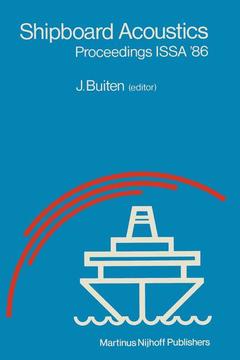Shipboard Acoustics, 1986 Proceedings of the 2nd International Symposium on Shipboard Acoustics ISSA '86, The Hague, The Netherlands, October 7-9, 1986
Langue : Français
Coordonnateur : Buiten J.

The first International Symposium on Shipboard Acoustics, held in Noordwijkerhout (The Netherlands) in 1976, was a meeting of invited experts, each having considerable expertise in ship acoustics. Many of the participants were dealing with research on various ship acoustical subjects, and it proved to be a good idea to discuss future investigations and new techniques. At that time acousticians learned to use real-time signal-processing techniques and attempts were made to establish sound level prediction methods based on semi-fundamental considerations instead of the methods using empirically obtained data. Time was pressing as it was assumed that, in view of the adoption of Recommendation 141 of the International Labour Conference in 1970, authorities would soon make appropriate provisions to "protect seafarers from the ill effects of noise". This resulted in several national recommendations followed by the IMO "Code on noise levels aboard ships" which was adopted by the IMO Assembly in 1981. After that, pressure on the authorities was increased further by the decision of the European Community to protect labourers against harmful noise at their workplaces, including ships. Legally enforceable noise limits will therefore become normal in the future. In many countries recommendations with respect to maximum allowable sound pressure levels in the crew accomodations and work area aboard ships were already taken into account by ship owners, long before the existence of the Recommendations.
1. Prediction Method for the Acoustic Source Strength of Propeller Cavitation.- 2. Propeller Induced Noise and Vibration Reduction: Acquired Experience in Design and Testing Approach.- 3. Experimental and Analytical Aspects of Propeller Induced Pressure Fluctuations.- 4. Model and Full Scale Measurements of Propeller Cavitation Noise on an Oceanographic Research Ship with Two Different Types of Screw Propeller.- 5. A Study of Simulation and Elimination of Propeller Singing.- 6. Propeller Noise: Some Topics from the Activities of Brodarski Institute.- 7. Some Experiments on the Transmission of Propeller Cavitation Noise into the Ship’s Structure.- 8. Quiet High-Speed Yachts and Water Jet Applications.- 9. Model-Scale Measurements of the Transmission and Radiation of Hull-Borne Vibrational Energy Using Frequency/Wavenumber Analysis.- 10. Underwater Noise Radiation Due to Transmission through the Cooling Water System of a Marine Diesel Engine.- 11. Measurements of Underwater Acoustic Intensity in the Nearfield of a Point Excited Periodically Ribbed Cylinder.- 12. Sound Generation from a Moving Shell.- 13. Low Noise Levels as the First Task of a Vessel. A Description and Some Remarks about Acoustic Quieting Design Criteria and Features of Saclant ASW Centre Oceanographic Research Vessel.- 14. Ship Noise Criteria. Do They Reflect the Present Level of Noise Reduction Technology?.- 15. A Literature Survey Concerning Propeller as a Noise Source and Prediction Methods of Structure-Borne Noise in Ships.- 16. Applications of Two Mathematical Approaches to Predict Airborne Noise Levels in Ship Superstructures.- 17. Some Observations on the Achievable Properties of Diesel Isolation Systems.- 18. Acoustic Transfer Functions of Flexible Shaft Couplings; Measurement Method and Results.- 19. Random Vibration of Multiterminal Mechanical Systems.- 20. The Influence of the Internal Impedance on Vibration Reduction.- 21. Main Propulsion Diesel Generator Sets with Acoustic Enclosure and Double Resilient Mounting for Low Noise Application.- 22. Flexural Wave Damping in Ship Hulls, Decks and Bulkheads.- 23. Determination of Acoustic Properties of Ship’s Sound Reducing Floors.- 24. Study of Structure-Borne Noise Transmission Inside Cabins by Sound-Intensity Measurements.- 25. Experiments on Sound Reducing Floors Including Visco-Elastic-Damping on Board a Rhine Cruise Vessel.
Date de parution : 11-2013
Ouvrage de 576 p.
15.5x23.5 cm
Disponible chez l'éditeur (délai d'approvisionnement : 15 jours).
Prix indicatif 105,49 €
Ajouter au panierThèmes de Shipboard Acoustics :
Mots-clés :
© 2024 LAVOISIER S.A.S.



